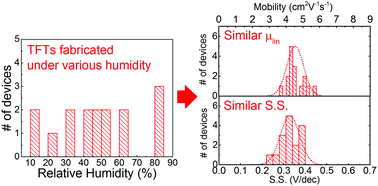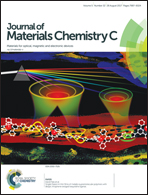Effect of relative humidity and pre-annealing temperature on spin-coated zinc tin oxide films made via the metal–organic decomposition route†
Abstract
Here we investigate the effect of relative humidity and pre-annealing temperature on multi-layer, solution-processed amorphous zinc tin oxide films formed by metal–organic decomposition (MOD). We show that changing the pre-annealing temperature can significantly change the metal stoichiometry and hydroxide content of zinc tin oxide films. Films pre-annealed at higher temperatures exhibit tin-rich, hydroxide-poor compositions and enhanced thin-film transistor performance, with an increase in field-effect mobility from 0.75 cm2 V−1 s−1 to 5.91 cm2 V−1 s−1 and a decrease in subthreshold voltage swing from 1.37 V decade−1 to 0.44 V decade−1. In contrast to conventional sol–gel methods, our solution-processed thin-film transistors made via the MOD route exhibit uniform performance over a wide range of process conditions. Intentional, controlled variation of relative humidity (RH) during film deposition from 10% RH to 83% RH results in little change in electron mobility (3.76 to 5.62 cm2 V−1 s−1) or subthreshold swing (0.23 to 0.39 V decade−1). The uniformity of film properties over a wide process window indicates the utility of the MOD approach for producing high-quality solution-processed semiconductors for large-area and printed electronics.



 Please wait while we load your content...
Please wait while we load your content...